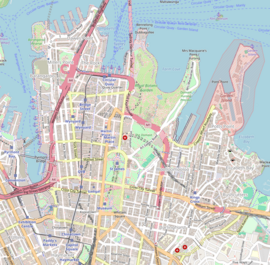
Martin Place is a pedestrian mall in the Sydney central business district, New South Wales, Australia. Martin Place has been described as the "civic heart" of Sydney. As home to the Reserve Bank of Australia, the Commonwealth Bank, Macquarie Bank, Westpac and other corporations, it is also a centre of business and finance. The Sydney GPO is also located on Martin Place.

The Downing Centre is a major heritage-listed former department store and now courthouse complex in Sydney, New South Wales, Australia. It features state government courts, including the Local Court, the District Court, and a law library known as the Downing Centre Library. The Downing Centre forms part of the Department of Communities and Justice and houses court services and sheriffs offices.

Castlereagh Street is a 1.6-kilometre-long (1 mi) major street located in the Sydney central business district in New South Wales, Australia. The street runs in a north-to-south, in a one way direction only.
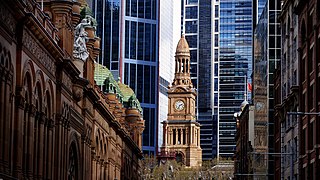
The architecture of Sydney, Australia’s oldest city, is not characterised by any one architectural style, but by an extensive juxtaposition of old and new architecture over the city's 200-year history, from its modest beginnings with local materials and lack of international funding to its present-day modernity with an expansive skyline of high rises and skyscrapers, dotted at street level with remnants of a Victorian era of prosperity.
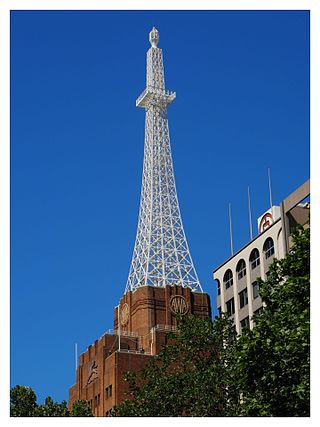
The AWA Tower is a heritage-listed office and communications complex in Sydney, in the state of New South Wales, Australia built for Amalgamated Wireless Australasia Limited. The AWA Tower consists of a radio transmission tower atop a 15-storey building. It is located in the Sydney central business district at 45-47 York Street, close to Wynyard Park and Wynyard railway station. It was designed by Robertson, Marks and McCredie in association with DT Morrow and Gordon and built from 1937 to 1939 by William Hughes and Co. Pty Ltd. It was added to the New South Wales State Heritage Register on 2 April 1999.
Australian non-residential architectural styles are a set of Australian architectural styles that apply to buildings used for purposes other than residence and have been around only since the first colonial government buildings of early European settlement of Australia in 1788.

Hong Kong House, also known since 1995 as the Hong Kong Economic and Trade Office, Sydney, is a landmark heritage building and former hotel in the Sydney central business district, City of Sydney, New South Wales, Australia. Built in 1891 to a design by Ambrose Thornley, it is located on 80 Druitt Street, at the corner with York Street, and is adjacent to other prominent heritage landmarks, the Sydney Town Hall and the Queen Victoria Building. Formerly known as Gresham Hotel, the property was added to the New South Wales State Heritage Register on 2 April 1999.

The State Savings Bank Building is a heritage-listed large bank building and commercial offices situated at 48–50 Martin Place, in the Sydney central business district in the City of Sydney local government area of New South Wales, Australia. It was designed by Ross & Rowe Architects and Consulting Engineers and built from 1925 to 1928 by Concrete Constructions Ltd. It is also known as The Government Savings Bank of New South Wales, Commonwealth Bank building (former), and CBA Building. After several decades of use by the Commonwealth Bank of Australia, including as its headquarters from 1984, it was purchased by financial services company Macquarie Group in 2012, refurbished, and now serves as Macquarie's global headquarters as 50 Martin Place. It was added to the New South Wales State Heritage Register on 17 November 2000.

The State Theatre is a heritage-listed theatre, located at 47-51 Market Street, in the Sydney central business district in the City of Sydney local government area of New South Wales, Australia. The theatre was designed by Henry Eli White with assistance from John Eberson and built between 1926 and 1929. It hosts film screenings, live theatre and musical performances, and since 1974 it has been the home of the annual Sydney Film Festival. It is also known as State Building and Wurlitzer Organ. The property is privately owned. It was added to the New South Wales State Heritage Register on 2 April 1999.
Henry "Harry" Ebenezer Budden was a Sulman Award winning Australian architect active in the first 40 years of the 20th century. His work encompassed the styles of the Federation Arts and Crafts and Bungalow through to the Inter-War Stripped Classical and Art Deco. He was a leader of his profession and in the wider community, serving as the first Australian War Chest Commissioner during World War I.
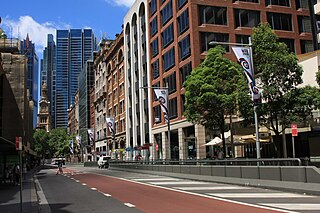
York Street is a street in the Sydney central business district in New South Wales, Australia. York Street runs 1.050 kilometres (0.652 mi) in a north to south direction only and is used predominantly by buses from the northern districts of Sydney.
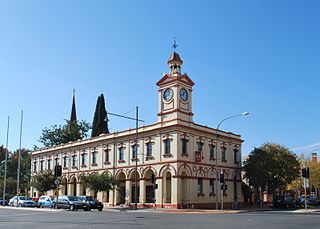
Albury Post Office is a heritage-listed post office at 570 Dean Street, Albury, City of Albury, New South Wales, Australia. It was designed by NSW Colonial Architects Office under James Barnet and built in 1880. The property is owned by Australia Post. It was added to the New South Wales State Heritage Register on 17 December 1999. On 8 November 2011 the building was listed on the Commonwealth Heritage List; and is listed on the Register of the National Estate since 21 March 1978.

The Australian Hotel is a heritage-listed hotel at 100–104 Cumberland Street, The Rocks, City of Sydney, New South Wales, Australia. The current structure was constructed from 1914 to 1915, and Property NSW owns the property, being added to the New South Wales State Heritage Register on 10 May 2002.

Science House is a heritage-listed commercial building located at 157–169 Gloucester Street and Essex Street, in the inner city Sydney suburb of The Rocks in the City of Sydney local government area of New South Wales, Australia. It was designed by Peddle Thorp & Walker Architects and built in 1930 by John Grant and Sons, Master Builders. It was also known as Sports House from 1978–1991. The building is owned by Denwol, a property group owned and controlled by Phillip Wolanski AM. It was added to the New South Wales State Heritage Register on 10 May 2002.

The Sydney Water Head Office, now known as Kimpton Margot Sydney is a heritage-listed hotel, formerly an office building, located in the Sydney central business district in New South Wales, Australia. It was designed by Henry Budden & Mackey and built from 1938 to 1939 by Howie Moffat & Co, commonly called the Water Board Building and formally the Metropolitan Water, Sewerage and Drainage Board Headquarters. Following Sydney Water's relocation to Parramatta in 2009, it was converted into a hotel (as The Primus Hotel, part of a chain of hotels owned by the municipal government of Shanghai, while the adjoining 1969 office building was redeveloped to become the Greenland Centre. In 2021, Primus Hotel Sydney closed, and in 2022 the hotel re-opened as part of the Kimpton chain operated by IHG Hotels & Resorts.

AMA House, Sydney or the Australian Medical Association House, Sydney is a heritage-listed former medical office and library and now commercial offices located at 135–137 Macquarie Street in the Sydney central business district, in the City of Sydney local government area of New South Wales, Australia. It was designed by Fowell & McConnel and built from 1929 to 1930 by Messrs Hutcherson Bros. It was formerly known as BMA House or the British Medical Association House. The property is privately owned. It was added to the New South Wales State Heritage Register on 2 April 1999.

The MLC Building is a heritage-listed office building located at 42–46 Martin Place in the Sydney central business district, in the City of Sydney local government area of New South Wales, Australia. It was designed by Bates Smart & McCutcheon and built from 1936 to 1938 by Concrete Constructions Limited. It is also known as Mutual Life & Assurance Building. It was added to the New South Wales State Heritage Register on 2 April 1999. From the time of its construction and for many years thereafter, the building served as the offices for Australian life insurance company, Mutual Life & Citizens Assurance Company Limited. As of December 2018 the anchor tenant was Norton Rose Fulbright, formerly Henry Davis York, an international law firm.
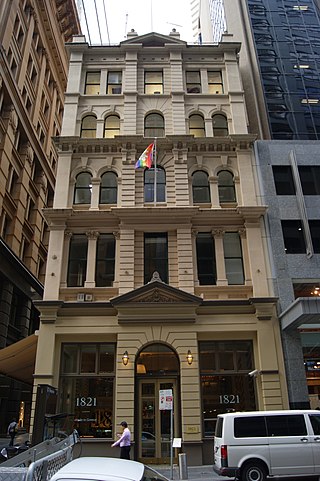
The Sydney Club is a heritage-listed club premises at 122 Pitt Street, in the Sydney central business district, in the City of Sydney local government area of New South Wales, Australia. It was designed by Mansfield Brothers and built from 1886 to 1887 by A & A Scott. It is also known as Million House. It was added to the New South Wales State Heritage Register on 2 April 1999.

161 Sussex Street is a heritage-listed historic site located at 161 Sussex Street, in the Sydney central business district, in the City of Sydney local government area of New South Wales, Australia. The property is owned by Property NSW, an agency of the Government of New South Wales. It was added to the New South Wales State Heritage Register on 2 April 1999.

